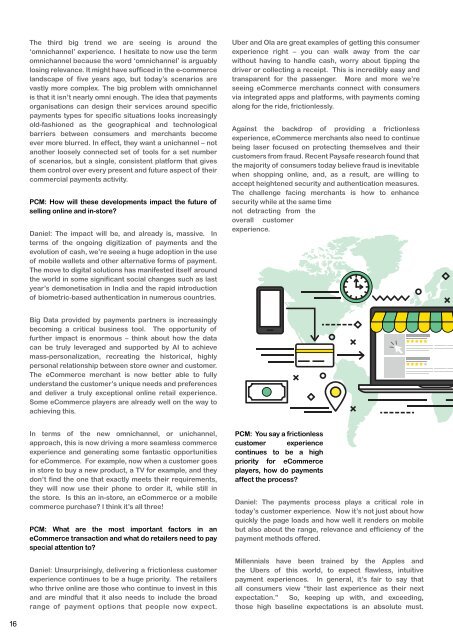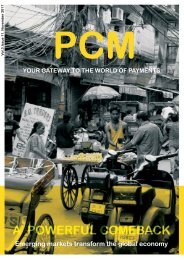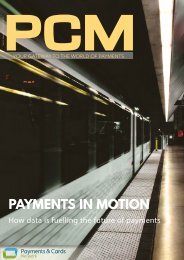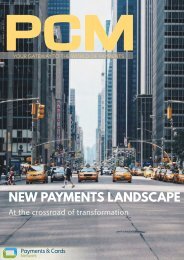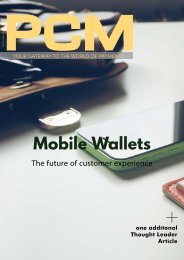PCM Vol.3 Issue 12
In this issue, we will explore the development of eCommerce, the upcoming trends in 2018 and the key challenges eCommerce merchants face trying to keep up with the fast-paced changes.
In this issue, we will explore the development of eCommerce, the upcoming trends in 2018 and the key challenges eCommerce merchants face trying to keep up with the fast-paced changes.
Create successful ePaper yourself
Turn your PDF publications into a flip-book with our unique Google optimized e-Paper software.
The third big trend we are seeing is around the<br />
‘omnichannel’ experience. I hesitate to now use the term<br />
omnichannel because the word ‘omnichannel’ is arguably<br />
losing relevance. It might have sufficed in the e-commerce<br />
landscape of five years ago, but today’s scenarios are<br />
vastly more complex. The big problem with omnichannel<br />
is that it isn’t nearly omni enough. The idea that payments<br />
organisations can design their services around specific<br />
payments types for specific situations looks increasingly<br />
old-fashioned as the geographical and technological<br />
barriers between consumers and merchants become<br />
ever more blurred. In effect, they want a unichannel – not<br />
another loosely connected set of tools for a set number<br />
of scenarios, but a single, consistent platform that gives<br />
them control over every present and future aspect of their<br />
commercial payments activity.<br />
<strong>PCM</strong>: How will these developments impact the future of<br />
selling online and in-store?<br />
Daniel: The impact will be, and already is, massive. In<br />
terms of the ongoing digitization of payments and the<br />
evolution of cash, we’re seeing a huge adoption in the use<br />
of mobile wallets and other alternative forms of payment.<br />
The move to digital solutions has manifested itself around<br />
the world in some significant social changes such as last<br />
year’s demonetisation in India and the rapid introduction<br />
of biometric-based authentication in numerous countries.<br />
Uber and Ola are great examples of getting this consumer<br />
experience right – you can walk away from the car<br />
without having to handle cash, worry about tipping the<br />
driver or collecting a receipt. This is incredibly easy and<br />
transparent for the passenger. More and more we’re<br />
seeing eCommerce merchants connect with consumers<br />
via integrated apps and platforms, with payments coming<br />
along for the ride, frictionlessly.<br />
Against the backdrop of providing a frictionless<br />
experience, eCommerce merchants also need to continue<br />
being laser focused on protecting themselves and their<br />
customers from fraud. Recent Paysafe research found that<br />
the majority of consumers today believe fraud is inevitable<br />
when shopping online, and, as a result, are willing to<br />
accept heightened security and authentication measures.<br />
The challenge facing merchants is how to enhance<br />
security while at the same time<br />
not detracting from the<br />
overall customer<br />
experience.<br />
Big Data provided by payments partners is increasingly<br />
becoming a critical business tool. The opportunity of<br />
further impact is enormous – think about how the data<br />
can be truly leveraged and supported by AI to achieve<br />
mass-personalization, recreating the historical, highly<br />
personal relationship between store owner and customer.<br />
The eCommerce merchant is now better able to fully<br />
understand the customer’s unique needs and preferences<br />
and deliver a truly exceptional online retail experience.<br />
Some eCommerce players are already well on the way to<br />
achieving this.<br />
In terms of the new omnichannel, or unichannel,<br />
approach, this is now driving a more seamless commerce<br />
experience and generating some fantastic opportunities<br />
for eCommerce. For example, now when a customer goes<br />
in store to buy a new product, a TV for example, and they<br />
don’t find the one that exactly meets their requirements,<br />
they will now use their phone to order it, while still in<br />
the store. Is this an in-store, an eCommerce or a mobile<br />
commerce purchase? I think it’s all three!<br />
<strong>PCM</strong>: What are the most important factors in an<br />
eCommerce transaction and what do retailers need to pay<br />
special attention to?<br />
Daniel: Unsurprisingly, delivering a frictionless customer<br />
experience continues to be a huge priority. The retailers<br />
who thrive online are those who continue to invest in this<br />
and are mindful that it also needs to include the broad<br />
range of payment options that people now expect.<br />
<strong>PCM</strong>: You say a frictionless<br />
customer experience<br />
continues to be a high<br />
priority for eCommerce<br />
players, how do payments<br />
affect the process?<br />
Daniel: The payments process plays a critical role in<br />
today’s customer experience. Now it’s not just about how<br />
quickly the page loads and how well it renders on mobile<br />
but also about the range, relevance and efficiency of the<br />
payment methods offered.<br />
Millennials have been trained by the Apples and<br />
the Ubers of this world, to expect flawless, intuitive<br />
payment experiences. In general, it’s fair to say that<br />
all consumers view “their last experience as their next<br />
expectation.” So, keeping up with, and exceeding,<br />
those high baseline expectations is an absolute must.<br />
16


